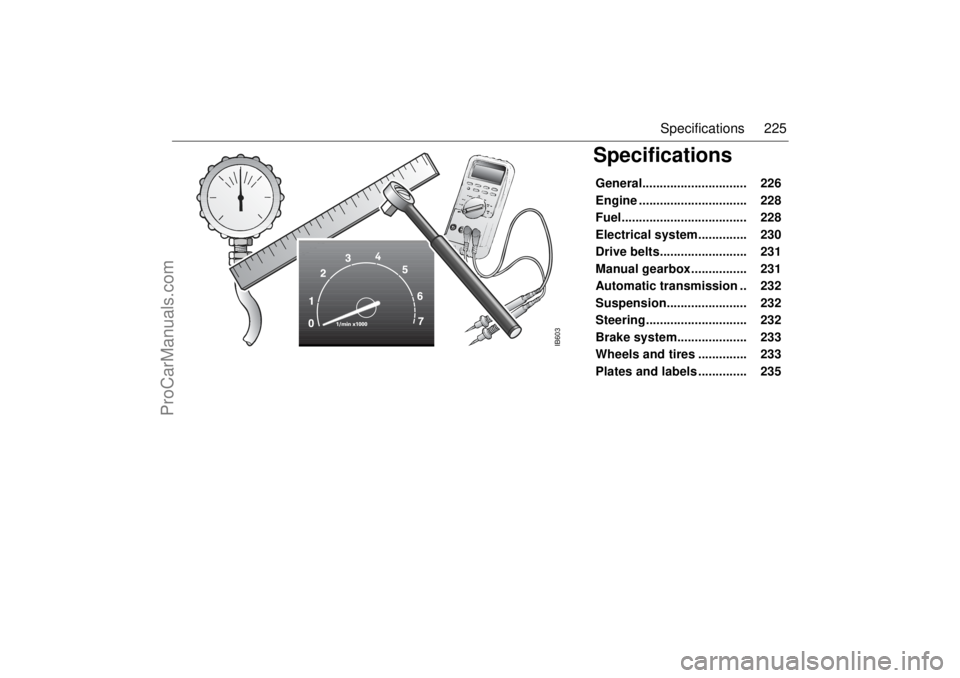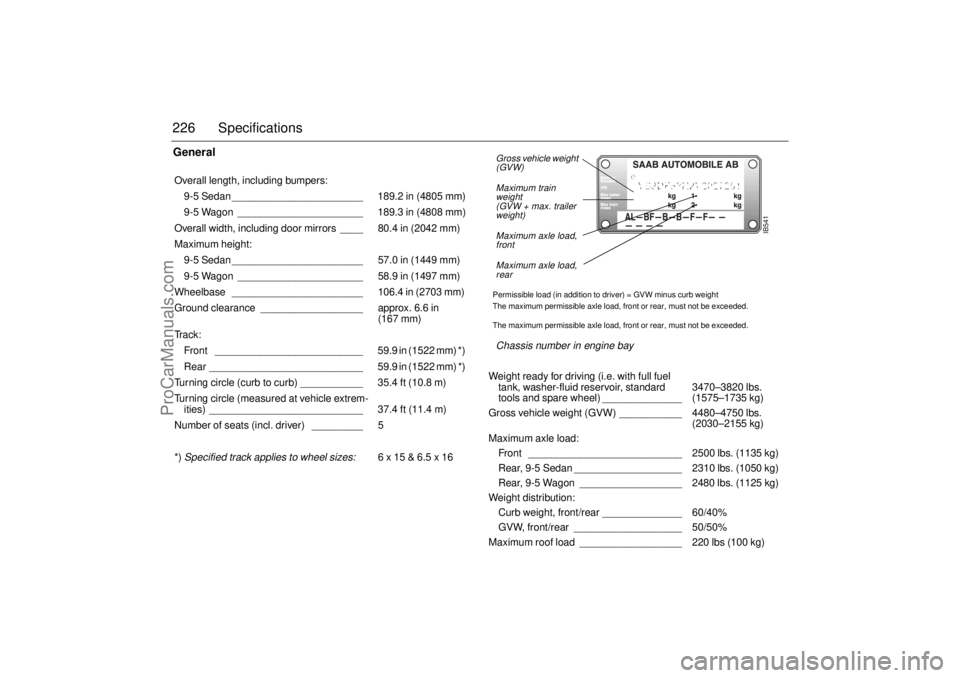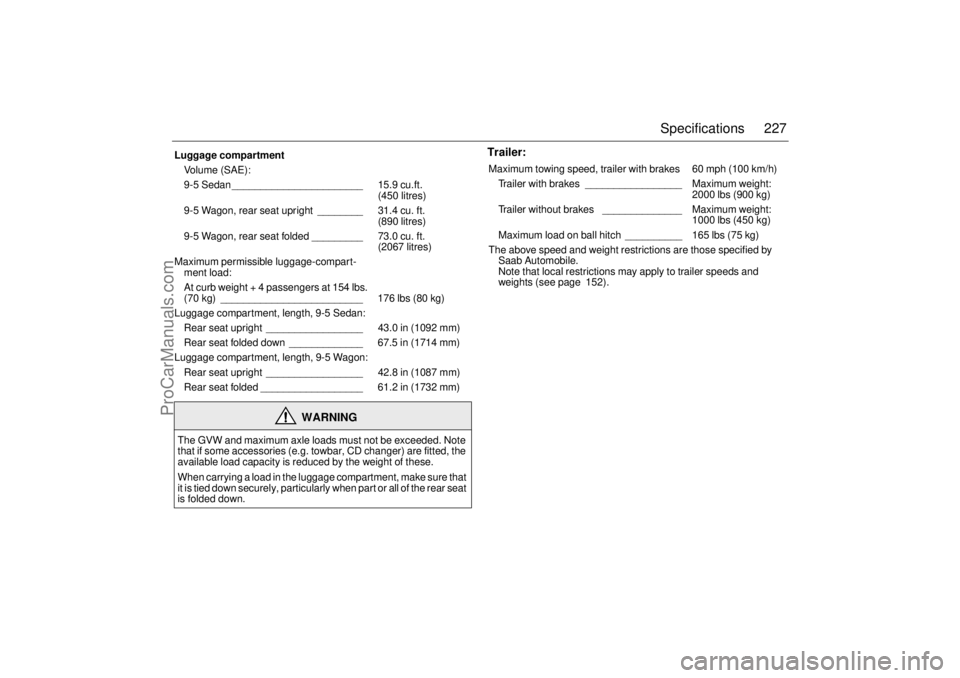SAAB 9-5 2000 Owners Manual
Manufacturer: SAAB, Model Year: 2000, Model line: 9-5, Model: SAAB 9-5 2000Pages: 256, PDF Size: 14.24 MB
Page 221 of 256

221 Maintenance and owner assistance
Saab Original Service Program M2000 USA, Canada, 9-5 Models)* These are the minimum required Emission Control System maintenance steps. Saab urges that all recommended maintenance procedures be performed
according to this program.
(a.) Engine oil and filter should be changed at least once a year. Intermediate oil and filter changes (halfway between indicated intervals) suggested for
cars primarily used for driving in dense city traffic or for repeated short trip operation without sufficient warm up.
*** Camshaft drive belt replacements (V6) prior to 100,000 miles will be performed at no charge by an authorized U.S. or Canadian Saab dealer.
** Service intervals:
Refer to the Warranties & Service Record Book for service intervals beyond 100,000 miles (160,000 km).Service Intervals **
Miles = U.S. Cars
Kilometers = Canadian Cars
1,000
(1,600 km)
10,000
(16,000 km)
20,000
(32,000 km)
30,000
(48,000 km)
40,000
(64,000 km)
50,000
(80,000 km)
60,000
(96,000 km)
70,000
(112,000 km)
80,000
(128,000 km)
90,000
(144,000 km)
100,000
(160,000 km)
Service #
1234567891011
Engine and engine compartment
E Engine oil and filter (a.)!!!!!!!!!!!
R Engine coolant freezing point and level""" "" "" "
R Engine coolant flush and replace (max. 3-year intervals)!!!
R Engine coolant system, hoses and cap" """""""""
R Drive belt, condition""""" ! """"
R Camshaft drive belt (V6) ***!
E Spark plugs!
*
!*
!*
Application/type of service (col. 1) Service Procedure
E = emission service"= Check - top up, adjust or replace if necessary
R = regular maintenance!= Replace
#= Lubricate
ProCarManuals.com
Page 222 of 256

222 Maintenance and owner assistance* These are the minimum required Emission Control System maintenance steps. Saab urges that all recommended maintenance procedures be performed
according to this program.
(b.) Change automatic transmission fluid at more frequent intervals (20,000; 50,000; 80,000 miles, etc.) if car is driven in dense city traffic where the outside
temperature regularly reach 90°F or higher, or if car is used in a mountainous/high altitude area or for trailer towing.
Service Intervals **
Miles = U.S. Cars
Kilometers = Canadian Cars
1,000
(1,600 km)
10,000
(16,000 km)
20,000
(32,000 km)
30,000
(48,000 km)
40,000
(64,000 km)
50,000
(80,000 km)
60,000
(96,000 km)
70,000
(112,000 km)
80,000
(128,000 km)
90,000
(144,000 km)
100,000
(160,000 km)
Service #
1234567891011
Engine and engine compartment (cont.)
E Evaporative emission system including filler cap, vapor
lines, EVAP canister and canister purge valve"
R Fuel system: leaks and damage""""""""""
E Fuel filter!
E Engine air cleaner element!
*
!*
!*
R Exhaust system and mountings; leaks and condition""""""""""
Electrical
R Battery: state of charge and electrolyte level; clean termi-
nals if necessary"""""""""""
R Head, fog, brake, tail, turn signal, warning lights instru-
ment panel, backup and marker lamps"""""""""""
Transmission
R Automatic transmission fluid change (b.)!!!
R Automatic gearbox oil level"""""""""""
R Manual gearbox oil level"""
R Outer and inner driver joint boots""""""""""
ProCarManuals.com
Page 223 of 256

223 Maintenance and owner assistance
(c.) Check wheel alignment if irregular or premature tire wear is apparent.
Service Intervals **
Miles = U.S. Cars
Kilometers = Canadian Cars
1,000
(1,600 km)
10,000
(16,000 km)
20,000
(32,000 km)
30,000
(48,000 km)
40,000
(64,000 km)
50,000
(80,000 km)
60,000
(96,000 km)
70,000
(112,000 km)
80,000
(128,000 km)
90,000
(144,000 km)
100,000
(160,000 km)
Service #
1234567891011
Chassis
R Ball joint clearance, outer and inner steering joints and
rubber boots""""""""""
R Front suspension, rear axle mountings; retighten"
R Shock absorbers and bushes; tightness and condition"""
R Tire pressure, tread depth and wear (c.)"""""""""""
R Rotate tires, front to rear""""""""""
R Brake pads and discs; wear and condition""""""""""
R Brake lines and hoses"""""""""""
R Brake fluid level and renewal (max. 2-year intervals)""" ! "" ! "" ! "
R Check handbrake function"""""""""""
R Power steering fluid level"""""""""""
ProCarManuals.com
Page 224 of 256

224 Maintenance and owner assistance
Service Intervals **
Miles = U.S. Cars
Kilometers = Canadian Cars
1,000
(1,600 km)
10,000
(16,000 km)
20,000
(32,000 km)
30,000
(48,000 km)
40,000
(64,000 km)
50,000
(80,000 km)
60,000
(96,000 km)
70,000
(112,000 km)
80,000
(128,000 km)
90,000
(144,000 km)
100,000
(160,000 km)
Service #
1234567891011
Chassis (cont.)
RToe-in"""
R Cabin air filter!!!
R Cabin air absorptive filter!
R Door hinges, stops and locks###
R Airbag system, SRS warning lamps, visual inspection"""""""""""
R Safety belts; operation and visual inspection of belt for
tears and fraying"""""""""""
RWipers"""""""""""
R Washer system: check and top-up"""""""""""
R Reset service indicator""""""""""
Customer programming
R Carry out systems programming per customer request"
Road test
R Check performance of drive train, steering and brakes
and verify tire balance.
Check function of instruments and controls, including
horn, windshield wipers, cruise control and climate sys-
tem.
Note any noises or problems for correction."""""""""""
ProCarManuals.com
Page 225 of 256

225 Specifications
Specifications General.............................. 226
Engine ............................... 228
Fuel.................................... 228
Electrical system.............. 230
Drive belts......................... 231
Manual gearbox................ 231
Automatic transmission .. 232
Suspension....................... 232
Steering............................. 232
Brake system.................... 233
Wheels and tires .............. 233
Plates and labels .............. 235
IB603
ProCarManuals.com
Page 226 of 256

226 SpecificationsGeneral Overall length, including bumpers:
9-5 Sedan _______________________ 189.2 in (4805 mm)
9-5 Wagon ______________________ 189.3 in (4808 mm)
Overall width, including door mirrors ____ 80.4 in (2042 mm)
Maximum height:
9-5 Sedan _______________________ 57.0 in (1449 mm)
9-5 Wagon ______________________ 58.9 in (1497 mm)
Wheelbase _______________________ 106.4 in (2703 mm)
Ground clearance __________________ approx. 6.6 in
(167 mm)
Tr a c k :
Front __________________________ 59.9 in (1522 mm) *)
Rear ___________________________ 59.9 in (1522 mm) *)
Turning circle (curb to curb) ___________ 35.4 ft (10.8 m)
Turning circle (measured at vehicle extrem-
ities) ___________________________ 37.4 ft (11.4 m)
Number of seats (incl. driver) _________ 5
*) Specified track applies to wheel sizes:
6 x 15 & 6.5 x 16
Gross vehicle weight
(GVW)
Maximum train
weight
(GVW + max. trailer
weight)
Maximum axle load,
front
Maximum axle load,
rear Permissible load (in addition to driver) = GVW minus curb weight
The maximum permissible axle load, front or rear, must not be exceeded.
The maximum permissible axle load, front or rear, must not be exceeded. Chassis number in engine bay Weight ready for driving (i.e. with full fuel
tank, washer-fluid reservoir, standard
tools and spare wheel) ______________ 3470–3820 lbs.
(1575–1735 kg)
Gross vehicle weight (GVW) ___________ 4480–4750 lbs.
(2030–2155 kg)
Maximum axle load:
Front ___________________________ 2500 lbs. (1135 kg)
Rear, 9-5 Sedan ___________________ 2310 lbs. (1050 kg)
Rear, 9-5 Wagon __________________ 2480 lbs. (1125 kg)
Weight distribution:
Curb weight, front/rear ______________ 60/40%
GVW, front/rear ___________________ 50/50%
Maximum roof load __________________ 220 lbs (100 kg)
IB541
ProCarManuals.com
Page 227 of 256

227 Specifications
Trailer:
Luggage compartment
Volume (SAE):
9-5 Sedan _______________________ 15.9 cu.ft.
(450 litres)
9-5 Wagon, rear seat upright ________ 31.4 cu. ft.
(890 litres)
9-5 Wagon, rear seat folded _________ 73.0 cu. ft.
(2067 litres)
Maximum permissible luggage-compart-
ment load:
At curb weight + 4 passengers at 154 lbs.
(70 kg) _________________________ 176 lbs (80 kg)
Luggage compartment, length, 9-5 Sedan:
Rear seat upright _________________ 43.0 in (1092 mm)
Rear seat folded down _____________ 67.5 in (1714 mm)
Luggage compartment, length, 9-5 Wagon:
Rear seat upright _________________ 42.8 in (1087 mm)
Rear seat folded __________________ 61.2 in (1732 mm)
WARNING
The GVW and maximum axle loads must not be exceeded. Note
that if some accessories (e.g. towbar, CD changer) are fitted, the
available load capacity is reduced by the weight of these.
When carrying a load in the luggage compartment, make sure that
it is tied down securely, particularly when part or all of the rear seat
is folded down.
Maximum towing speed, trailer with brakes 60 mph (100 km/h)
Trailer with brakes _________________ Maximum weight:
2000 lbs (900 kg)
Trailer without brakes ______________ Maximum weight:
1000 lbs (450 kg)
Maximum load on ball hitch __________ 165 lbs (75 kg)
The above speed and weight restrictions are those specified by
Saab Automobile.
Note that local restrictions may apply to trailer speeds and
weights (see page 152).
ProCarManuals.com
Page 228 of 256

228 SpecificationsEngine Fuel4-cylinder ________________________ Four cylinders, twin
overhead cam-
shafts, 16 valves
and two balancer
shafts.
6-cylinder ________________________ V-6 engine, double
overhead cam-
shafts on each cyl-
inder bank,
24 valves
Cylinder bores ___________________ 3.54 in (90 mm)
Stroke:
4-cylinder engine _________________ 3.54 in (90 mm)
6-cylinder engine _________________ 3.34 in (85 mm)
Swept volume:
4-cylinder engine _________________ 139.7 cu.in
(2.290 litres)
6-cylinder engine _________________ 180.6 cu.in
(2.962 litres)
Idling speed:
4-cylinder _______________________ 825 rpm
6-cylinder _______________________ 700 rpm
Antifreeze ________________________ Saab-approved
antifreeze
Coolant capacity:
4-cylinder _______________________ 7.6 qts (7.4 litres)
6-cylinder _______________________ 7.4 qts (7.2 litres) Fuel grade ________________________ Unleaded gasoline
AON 87–93.
For optimum performance Saab recom-
mend the following fuel grades:
2.3t _____________________________ AON 90
2.3 Turbo Aero and V6-models________ AON 93 *)
*) If AON 90 is used and the ambient temperature is above
77 – 86°F (25– 30°C) some decrease in engine power can occur
to some extent.
Fuel-tank capacity __________________ 18.5 gal. (70 litres)
ProCarManuals.com
Page 229 of 256

229 Specifications
Engine oilOil specification
:
Oil for gasoline engines is classified in accordance with the API
standard (American Petroleum Institute) into the grade classes
SH (since 1993) and SJ (since 1996). The SJ class fulfils more
stringent requirements and has a lower level of phosphorous.
These grade classes are most often combined with the corre-
sponding classes for diesel engines. The class designations for
diesel engines begin with the letter “C” (Commercial). For exam-
ple, a grade combination suitable for both types of engine could
be API SH/CD or SJ/CF.
Under ACEA nomenclature, oils are divided into Class A for gas-
oline engines and Class B for diesel-engined passenger cars.
There is a further class for heavy diesel engines. Each class is
divided into three grades: 1, 2 and 3, where grades 2 and 3 nor-
mally encompass semi and fully-synthetic oils.
In the same way as in the API system, gasoline and diesel
engine specifications are combined for products that can be
used in both types of engine. For example, a grade designation
could be ACEA A2/B2 or ACEA A3/B3.
To afford Saab engines the best protection with regard to lubri-
cation, the ability to dissolve residues and the neutralization of
combustion products, we recommend the following oil grades:
API SH/CD/CF or SJ/CD/CF.
ACEA A2/B2 or A3/B3.
These oils contain the additives required for the engine to
function well. We advise against the use of further addi-
tives.
Viscosity
:
The viscosity of oil is classified according to the SAE standard.
Nowadays, multigrade oils are always used in car engines. The
properties of these oils facilitate starting the car in cold weather
but mean that the oil is also viscous enough to coat all moving
parts under high pressures and with high outside air tempera-
tures.
Multigrade oils are graded with two viscosities, e.g. 10W-30,
where the 10W meets certain viscosity requirements at -20°C,
while the 30 fulfils requirements at a temperature of 100°C.
Basic recommendations for Saab engines:
SAE 10W-30 or 10W-40.
SAE 5W-30 can also be recommended but in which case the oil
must be semi of fully-synthetic and fulfil ACEA grade require-
ments A3/B3.
Oils which are less viscous, such as 0W/-40/50 are becoming
more common and may be used. However, the oil must be
fully-synthetic, of a well known brand, and fulfil ACEA grade
requirements A3/B3.
This viscosity makes starting in cold weather easier.
Oil capacity incl. filter (on changing):
4-cylinder ________________________ 4.1 qts (4.0 litres)
6-cylinder ________________________ 4.6 qts (4.5 litres)
ProCarManuals.com
Page 230 of 256

230 SpecificationsEngine variants Electrical system2.3t Ecopower Rating, EEC at 5500 rpm ___________ 170 hp (125 kW)
Maximum torque, EEC at 1800 rpm ___ 207.2 ft.lb
(280 Nm)
Compression ratio ________________ 9.35:1 2.3 Turbo Ecopower (“Aero“ model engine),
manual transmissionRating, EEC at 5500 rpm ___________ 230 hp (169 kW)
Maximum torque, EEC at 1900 rpm 259.0 ft.lb.
(350 Nm)
Compression ratio ________________ 9.3:12.3 Turbo Ecopower, (“Aero“ model engine)
automatic transmissionRating, EEC at 5500 rpm ___________ 230 hp (169 kW)
Maximum torque, EEC at 1900 rpm 244.2 ft.lb.
(330 Nm)
Compression ratio ________________ 9.3:13.0t Ecopower Rating, EEC at 5000 rpm ___________ 200 hp (147 kW)
Maximum torque, EEC at 2100 rpm ___ 229.4 ft.lb
(310 Nm)
Compression ratio ________________ 9.5:1 Voltage ___________________________ 12 V
Battery capacity ____________________ 60 Ah or 70 Ah
Starter motor ______________________ 1.4 kW
Alternator rating ____________________ 130 A/14 V
Firing order:
4-cylinder ________________________ 1-3-4-2
6-cylinder ________________________ 1-2-3-4-5-6
Spark plugs:
2.3t ____________________________ NGK
BCPR 6ES-11
2.3 Turbo ________________________ NGK
PFR 7H-10
6-cylinder ________________________ NGK
BKR 7ES-11
Electrode gap ______________________ 0.0394 +0.00394 in
(1.0+0.1 mm)
ProCarManuals.com